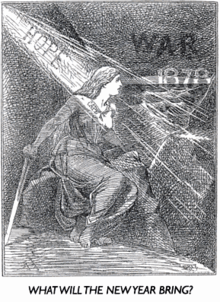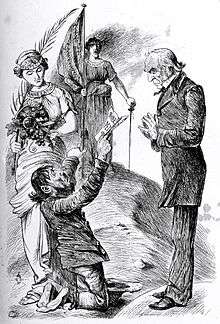The Lantern (Cape newspaper)
The Lantern was a weekly newspaper that was published in Cape Town from 1877 until the 1880s. It took a strongly pro-imperialist "jingoist" stance and was one of the earliest newspapers in southern Africa to feature satirical cartoons.



The Lantern was owned and edited by an English immigrant Alfred A. Geary, but after he died from a long illness in 1880, it was taken over by Irishman Thomas McCombie. Its exact reach is unknown but it did not approach the mainstream newspapers such as the Times and Cape Argus in its distribution. Its readership was primarily composed of white British immigrant workers, in whose ethnic mobilisation the paper played an important role.
Its populist articles took a strong position in favour of British imperial expansion in southern Africa, stronger ties with the British Empire, and a greater sense of ethnic identity for those of British descent. It typically attacked the mainstream press outlets such as Saul Solomon's newspaper the Cape Argus, for being "Negrophilist". It also strongly opposed any expansion of the multi-racial Cape Qualified Franchise.[1]
The Lantern (like its predecessor The Zingari) featured political cartoons that lampooned the political figures and issues of the day, primarily from a strongly pro-British point of view. The lead cartoonists were William Howard Schröder and Hugh Fisher ("Skit"). Another artist whose work was occasionally used was Frank Sutton Vane Bennett (1847-16 March 1913), who used the pen name "Vane Bennett" or "VB" and who came out to the Cape with theatre manager Disney Roebuck in 1875. Other contributing artists included Erling D Haslam, Henry Mills and Alpine Menzies.[2][3]
The paper began to run into severe financial difficulties in the mid-1880s. Beset with debts, McCombie moved to the Transvaal in 1889 to restart the paper there. Further inability to meet his financial engagements meant that, after starting a series of papers in Johannesburg, McCombie moved back to Cape Town where he was found drowned at Salt River.[4]
References
- V.Bickford-Smith: Ethnic Pride and Racial Prejudice in Victorian Cape Town. Cambridge University Press, 2003.
- K.Vernon: Penpricks: The Drawing of South Africa's Political Battlelines. New Africa Books, 2000.
- A.Mason: What's So Funny?: Under the Skin of South African Cartooning. Juta and Company Ltd, 2009.
- Reporter, The Media (May 30, 2011). "When the presses ran green". Retrieved October 12, 2019.
External link
![]()